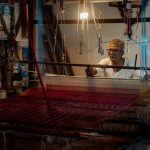If you need fabric that can handle extreme heat, chemicals, and wear, silicone coated aramid fabric is a solid choice. It combines the strength and heat resistance of aramid fibers with silicone’s added durability and water repellency. This makes it perfect for aerospace, automotive, and industrial insulation uses where toughness and flexibility matter. Plus, it resists abrasion better than many alternatives. Explore how its unique properties can boost your project’s performance and longevity.
Table of Contents
Key Takeaways
- Silicone coated aramid fabric offers exceptional heat and flame resistance for use in aerospace, automotive, and industrial insulation applications.
- The silicone coating enhances water repellency, durability, and thermal stability, preventing degradation and maintaining fabric integrity under extreme conditions.
- Its lightweight yet strong properties improve fuel efficiency and safety in aerospace and automotive industries without sacrificing performance.
- Silicone coated aramid fabric provides flexible, abrasion-resistant sealing solutions that withstand chemical exposure and high temperatures in industrial settings.
- Compared to other coated fabrics, it delivers superior elasticity, thermal stability, and longevity while maintaining flexibility at extreme temperatures.
Properties of Aramid Fibers
Aramid fibers boast exceptional strength and heat resistance, making them a top choice for protective fabrics. When you use aramid fibers, you get materials that withstand extreme temperatures without melting or burning, which is essential in hazardous environments.
These fibers also offer impressive tensile strength, so they resist stretching and tearing under pressure. You’ll appreciate that aramid fabrics are lightweight yet durable, allowing for comfort without sacrificing protection.
They resist chemical degradation and abrasion, so your gear lasts longer even with rough handling. Plus, aramid fibers have low flammability and excellent dimensional stability, maintaining their shape and integrity under stress.
With these properties, aramid fabrics provide reliable safety and resilience in demanding applications.
Benefits of Silicone Coating
You’ll find that silicone coating markedly boosts heat resistance, making the fabric withstand higher temperatures without damage.
It also improves water repellency, keeping the material dry and durable in wet conditions.
These benefits make silicone-coated aramid fabric ideal for demanding applications.
Enhanced Heat Resistance
Although high temperatures can quickly degrade many materials, silicone coating helps the fabric maintain its strength and flexibility even under intense heat.
When you use silicone coated aramid fabric, you benefit from its ability to withstand elevated temperatures without losing integrity. This coating acts as a protective barrier, reducing thermal degradation and preventing the fabric from becoming brittle or cracking.
You’ll find it ideal for applications where heat exposure is constant or sudden spikes occur, such as in firefighting gear or industrial insulation.
Plus, the enhanced heat resistance means the fabric lasts longer, saving you replacement costs and downtime.
Improved Water Repellency
When moisture comes into play, silicone coating greatly boosts the fabric’s water repellency, keeping it dry and functional.
You’ll find that water beads up and rolls off the surface instead of soaking in, which helps maintain the fabric’s strength and durability. This means you don’t have to worry about water damage or reduced performance in wet conditions.
Plus, the silicone layer prevents water from penetrating the fibers, so the fabric dries quickly and resists stains caused by moisture.
Whether you’re using it in outdoor gear, protective clothing, or industrial applications, this improved water repellency guarantees the material stays reliable and comfortable.
With silicone coating, you get a fabric that performs consistently, even when the environment gets damp or rainy.
Heat and Flame Resistance Capabilities
Because silicone coated aramid fabric combines the inherent strength of aramid fibers with the protective barrier of silicone, it offers exceptional heat and flame resistance. You’ll find it withstands high temperatures without melting or igniting, making it ideal for protective gear or industrial uses. The silicone coating also prevents degradation from prolonged heat exposure, enhancing durability. Here’s a quick comparison of its heat and flame resistance features:
| Feature | Benefit |
|---|---|
| High Ignition Point | Resists catching fire |
| Thermal Stability | Maintains integrity under heat |
| Silicone Barrier | Blocks heat transfer |
| Self-Extinguishing | Stops flame spread |
| Prolonged Heat Exposure | Retains strength and flexibility |
With these capabilities, you can trust this fabric to protect effectively in demanding conditions.
Use in Aerospace Industry
You’ll appreciate how silicone coated aramid fabric offers essential heat resistance in aerospace applications.
It helps reduce weight without sacrificing strength, which is important for performance and fuel efficiency.
Plus, its durability keeps it reliable even in the harshest environments you face up there.
Heat Resistance Benefits
Although aerospace environments demand materials that withstand extreme temperatures, silicone coated aramid fabric excels by offering exceptional heat resistance.
When you use this fabric, you benefit from its ability to maintain strength and integrity even under intense heat, protecting critical components from thermal damage. The silicone coating acts as a barrier against high temperatures, reducing the risk of material degradation during flight or re-entry.
This means you can rely on it for insulation blankets, thermal barriers, and protective covers that must endure rapid temperature changes. Additionally, its resistance to heat helps improve safety and durability, minimizing maintenance needs.
Weight Reduction Impact
Three key advantages make silicone coated aramid fabric a game-changer for weight reduction in aerospace.
First, its exceptional strength-to-weight ratio means you can replace heavier materials without sacrificing structural integrity. This helps you cut down overall aircraft weight, improving fuel efficiency and reducing emissions.
Second, the fabric’s flexibility allows for easier integration into complex shapes, minimizing the need for extra reinforcement and saving more weight.
Finally, its resistance to heat and chemicals guarantees you don’t have to add bulky protective layers, which often add unnecessary mass.
Durability in Harsh Environments
Anyone working in aerospace knows that materials must endure extreme conditions without failing. Silicone coated aramid fabric stands out because it resists high temperatures, chemicals, and abrasion, making it ideal for aerospace use.
When you rely on this fabric, you get unmatched durability, even in the harshest environments.
Here’s why it works so well:
- Withstands temperature fluctuations from -60°C to 260°C
- Resists fuel, oils, and hydraulic fluids without degrading
- Maintains tensile strength despite constant vibration and stress
- Offers excellent abrasion resistance during prolonged use
Automotive Industry Applications
Silicone coated aramid fabric offers impressive strength and heat resistance that makes it ideal for several automotive applications.
When you use this fabric, you benefit from its ability to withstand high temperatures, which is essential around engines and exhaust systems. It also resists abrasion and chemicals, so it holds up well in tough conditions under the hood.
You’ll find it in heat shields, protective covers, and insulation components, where safety and durability are priorities. Plus, its lightweight nature helps improve fuel efficiency by reducing overall vehicle weight.
If you’re aiming to enhance your vehicle’s performance and safety while maintaining durability, silicone coated aramid fabric provides a smart, reliable solution that meets the automotive industry’s demanding standards without compromise.
Firefighting and Protective Clothing
Because firefighting demands gear that can endure extreme heat and harsh conditions, aramid fabric coated with silicone is a top choice for protective clothing. You’ll find it in turnout gear, gloves, and helmets, where its heat resistance keeps you safe.
Aramid fabric coated with silicone delivers essential heat resistance for reliable firefighting gear like turnout suits and helmets.
The silicone coating adds water repellency and chemical resistance, helping you stay dry and protected from hazardous substances. Plus, it maintains flexibility so you can move swiftly in emergencies.
With silicone coated aramid fabric, you benefit from:
- Exceptional thermal protection against flames and radiant heat
- Enhanced durability for long-lasting gear performance
- Resistance to water, oils, and chemicals for added safety
- Lightweight material that won’t restrict your movements
This combination guarantees your protective clothing meets the rigorous demands of firefighting.
Industrial Insulation and Sealing
When you need materials that withstand high temperatures, silicone coated aramid fabric offers exceptional heat resistance for industrial insulation.
You’ll also find it provides durable sealing solutions that hold up under tough conditions. This fabric helps keep your systems protected and running efficiently.
Heat Resistance Benefits
Although many materials struggle under extreme temperatures, silicone coated aramid fabric stands out by maintaining its integrity and performance.
When you use this fabric, you get reliable heat resistance that protects your equipment and reduces maintenance needs. It withstands continuous exposure to high temperatures without degrading, making it ideal for demanding industrial environments.
You’ll appreciate how it helps prevent heat transfer, improving energy efficiency.
Here’s why this fabric benefits you:
- Resists temperatures up to 260°C (500°F) continuously
- Maintains flexibility without cracking or melting
- Offers excellent thermal insulation properties
- Protects against heat-related wear and tear
With these advantages, you can trust silicone coated aramid fabric to deliver consistent heat resistance where you need it most.
Durable Sealing Solutions
A durable sealing solution is essential for industrial insulation and sealing applications, and silicone coated aramid fabric delivers just that. You’ll find that its strength and flexibility create seals that withstand wear, temperature extremes, and chemical exposure. This fabric helps you maintain system integrity and reduces downtime caused by seal failure.
| Feature | Benefit |
|---|---|
| High tensile strength | Resists tearing and abrasion |
| Silicone coating | Provides chemical and heat resistance |
| Flexibility | Guarantees tight, adaptable seals |
| Lightweight | Easy to handle and install |
| Long lifespan | Lowers maintenance frequency |
When you use silicone coated aramid fabric, you get a reliable, cost-effective sealing option that keeps your industrial systems running smoothly.
Durability in Harsh Environments
Since extreme conditions can quickly degrade many materials, silicone coated aramid fabric stands out for its exceptional durability.
When you rely on it, you get resistance to heat, chemicals, and abrasion that few fabrics can match. This makes it ideal for tough environments where durability is non-negotiable.
You’ll find it maintains strength and flexibility even after prolonged exposure to harsh elements, making it a smart choice for demanding applications.
- Resists temperatures up to 260°C without losing integrity
- Withstands exposure to oils, solvents, and UV radiation
- Maintains tear and abrasion resistance in rough conditions
- Remains flexible and reliable in both wet and dry environments
Choosing this fabric means you don’t have to worry about frequent replacements or failures in challenging settings.
Comparison With Other Coated Fabrics
When you compare silicone coated aramid fabric to other coated fabrics, its balance of heat resistance, durability, and flexibility often sets it apart.
Unlike PVC coatings, silicone maintains flexibility at extreme temperatures without cracking, making it ideal for dynamic applications.
Silicone coatings stay flexible in extreme temperatures, preventing cracks and enhancing performance in dynamic conditions.
Compared to PTFE coatings, silicone offers better elasticity and easier handling while still resisting chemicals and UV exposure.
While polyurethane coatings provide good abrasion resistance, they typically don’t match silicone’s thermal stability or longevity in harsh environments.
If you need a fabric that withstands heat, harsh chemicals, and mechanical stress without sacrificing flexibility, silicone coated aramid fabric is often the superior choice.
This combination of properties makes it versatile across industries where performance under extreme conditions is non-negotiable.
Maintenance and Care Guidelines
Choosing silicone coated aramid fabric for its heat resistance and flexibility means you’ll want to keep it performing at its best through proper maintenance.
To extend its lifespan and maintain its protective qualities, handle the fabric with care and avoid exposing it to harsh chemicals or abrasive surfaces.
Here are key maintenance tips to follow:
- Clean gently with mild soap and water, avoiding harsh detergents.
- Store in a cool, dry place away from direct sunlight.
- Inspect regularly for signs of wear, tears, or coating damage.
- Avoid folding sharply; instead, roll to prevent creases that can weaken the fabric.
Frequently Asked Questions
Can Silicone Coated Aramid Fabric Be Recycled?
You can recycle silicone coated aramid fabric, but it’s challenging due to the coating and fiber blend. Specialized facilities handle this, so you’ll need to find a recycler experienced with composite materials for effective recycling.
What Is the Typical Lifespan of Silicone Coated Aramid Fabric?
Think of it as a trusty old friend—silicone coated aramid fabric typically lasts 5 to 10 years, depending on use and conditions. You’ll find it durable, but regular wear might shorten its reliable lifespan.
Are There Any Environmental Concerns With Silicone Coatings?
You might worry about environmental concerns since silicone coatings can be non-biodegradable. However, they’re generally considered safer than some alternatives, though improper disposal or production can still impact ecosystems negatively. Always recycle when possible.
How Does the Fabric Perform in Underwater Applications?
You’ll find the fabric performs well underwater, thanks to its water resistance and durability. It resists degradation, maintains strength, and handles pressure, making it ideal for marine gear and underwater protective applications where reliability is essential.
Is the Fabric Safe for Direct Skin Contact Over Long Periods?
Imagine wearing armor that’s both strong and gentle; you’ll find the fabric safe for long skin contact. It won’t irritate or harm you, letting you move freely while it protects, like a loyal guardian’s embrace.
- Does Chiffon Fabric Stink - July 15, 2025
- Does Chiffon Fabric Affect the Economy - July 15, 2025
- Does Cotton Fabric Have a Nap - July 15, 2025






